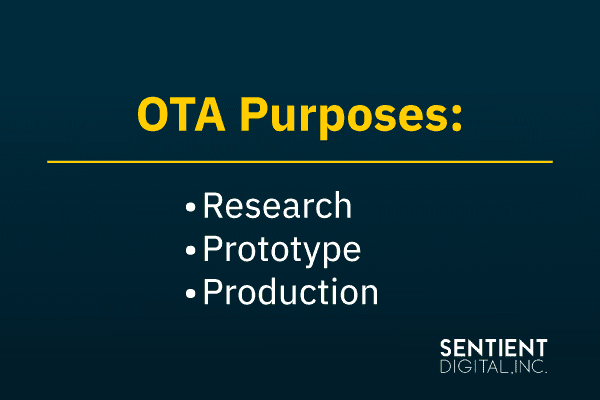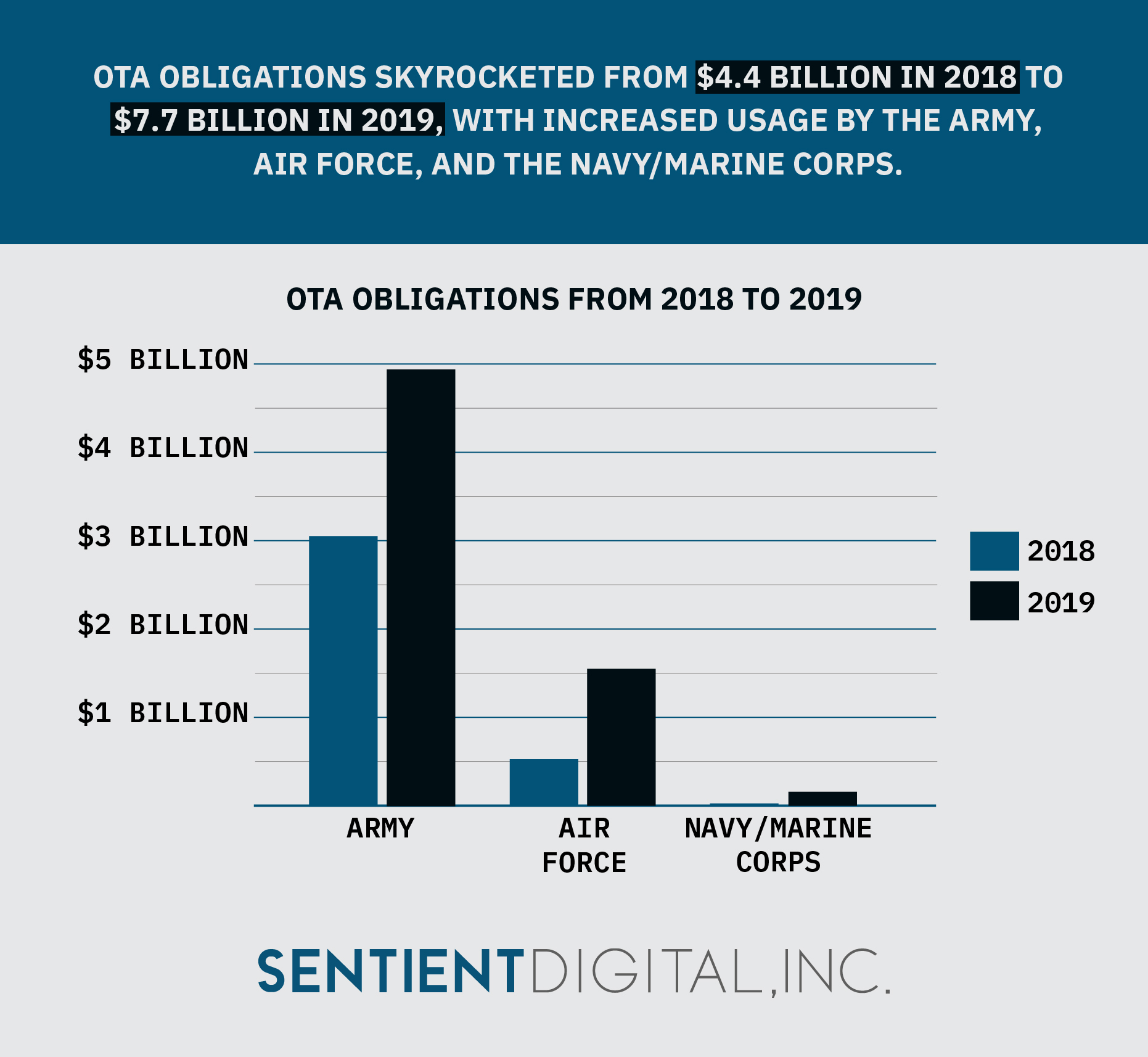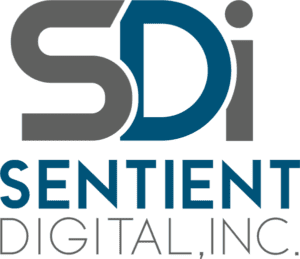If you’ve engaged in any kind of government contracting on a federal, state, or even local level, you may have heard about an OTA, or Other Transaction Authority. An OTA can provide an opportunity to bypass a complicated process, allowing for collaboration between government and the private sector. But what is an OTA in government contracting, exactly, and how can it benefit your organization?
OTAs are essentially an alternative to the traditional bidding process, designed for urgent, time-sensitive research, prototype, and production needs. An OTA can be an especially useful vehicle for non-traditional defense contractors, once you understand how to use it. But knowing what an OTA vehicle is under the Code of Federal Regulations, the relevant guidelines and purposes for using an OTA, and how contractors can benefit from OTAs can be a complicated matter for those who need it most.
As an organization that frequently contracts with government agencies, Sentient Digital and our subsidiary, RDA, have a lot of experience with the process. We’ve broken down all this and more so anyone can understand OTAs in government contracting, particularly those who want to participate in OTAs. Our commitment to the use of OTAs is such that we are pleased to announce that we have recently joined the Naval Aviation Systems Consortium (CMG NASC), Maritime Sustainment Technology and Innovation Consortium (MSTIC), National Armaments Consortium Advanced Technology International (NAC® – ATI), Expeditionary Missions Consortium – Crane (EMC2), C5, and Undersea Technology Innovation Consortium: UTIC. Additionally, we maintain our memberships in the Information Warfare Research Project (IWRP); Sensors, Communication, and Electronics Consortium (SCEC); System of Systems Security Consortium (SOSSEC); and Naval Surface Technology & Innovation Consortium (NSTIC). These OTAs will provide us with additional mechanisms by which to submit our ideas and services to the government. Learn more about the relationship we and other contractors have with OTAs below.
UNDERSTANDING an OTA in Government Contracting
WHAT IS FAR? An Introduction to the Traditional Acquisition Process
An understanding of the traditional acquisition process helps give context for the need for and benefits of OTAs. This section serves as a primer.
The Federal Acquisition Regulation (or FAR) is a set of clauses within the Code of Federal Regulations that makes up most of the code. FAR establishes the substantial and relatively complex rules for contracting within the Federal Government, including (but not limited to) provisions around changing the scope of work, making payments, conducting inspections, testing goods, and acceptance of goods. Its beginnings can be traced back to the Armed Services Procurement Regulations, which were established in 1947. All federal government agencies and government contractors who win contracts are required to follow the rules and policies set within FAR.
FAR can be amended when the three government agencies governed by it—the Department of Defense (DoD), NASA, and the General Services Administration (GSA)—and the FAR Council propose to do so under the “notice and comment” guidelines established by the Administrative Procedure Act, which was also established in 1947. Most relevantly, FAR was amended in March of 2020, which aligned the code with changes made by the Small Business Administration. This set a policy for partial set-asides of orders for small businesses under multiple-award contracts government-wide.
However, sometimes the Department of Defense will need access to research and development projects or prototypes from commercial services, along with more flexibility than the traditional FAR acquisition model allows—even if there is an amendment. This is where OTA steps in.
WHAT IS AN OTA IN GOVERNMENT CONTRACTING?

So, what is an OTA in government contracting and how does it help alleviate the bureaucratic hurdles that can delay the traditional process? An Other Transaction Authority (OTA) is a vehicle that federal agencies, specifically the DoD, can use to expedite and simplify access to important technology that they need faster than typical FAR protocol allows. These vehicles were first authorized in 1958 alongside the creation of NASA, but became available to DoD in 1989. OTAs were also created to give the DoD the flexibility to adapt to and incorporate business practices that reflect the current commercial industry standards and best practices that those standards change. In 2016, the National Defense Authorization Act (NDAA) gave the DoD the authority to award OTAs for research, prototype, and production purposes.
You may have heard of an “OTA contract.” However, technically there is actually no such thing as an OTA contract, because it isn’t a contract, grant, cooperative agreement, or formal selection process at all. Rather, it is an authority that allows government agencies to enter into transactions that must fall outside of FAR, usually due to the speed required for these critical projects.
As they are not based in FAR, OTAs do not follow the standard format or guidelines expected of contracts that fall within FAR. They also often do not include the many terms and conditions that FAR contracts or Department of Defense Grant and Agreement Regulations (DoDGARs) have. This flexibility makes them that much more appealing for non-traditional contractors to do work for the government.
OTA GUIDELINES
While there are fewer guidelines when using an OTA, compared to the complicated traditional contract process, OTAs do still have some restrictions.
Typically, the awardee must be a non-traditional defense contractor, which is a pretty broad start: that includes any commercial or academic institution. On top of that, a non-traditional contractor is defined as an entity not currently performing, and having not performed for at least one year prior to an OTA solicitation, either as:
- a contract or subcontract that was subject to full coverage under the Cost Accounting Standards (CAS), or
- any other contract greater than $700,000, under which the contractor is required to submit pricing data.
Occasionally, the awardees can be traditional defense contractors, but only if a non-traditional contractor is also considered as participating to a “significant” extent. Significant participation refers to any of the following:
- Supplying a new key technology or necessary product
- Fulfilling a significant amount of the effort
- Causing a material reduction in cost and/or schedule
However, an agency could ask to bypass these regulations in exceptional circumstances, which is permitted on occasion.
The OTA Basket
Another useful feature of OTAs is their ability to collect proposals in a “basket.” This means that when a proposal has been approved but the funding for a proposal is not currently available, it can be kept in a virtual basket for two years or more, meaning that if funding becomes available or there is an urgent need, the OTA can be more easily authorized, compared to having to start the process at square one.
Recent OTA Changes
As the usage of OTAs has expanded, so have calls for closer scrutiny of their use. With the passage of the 2022 National Defense Authorization Act (NDAA), Congress added further requirements for OTAs, with the objective of increasing transparency in the process.
Under the new requirements, the Secretary of Defense must notify Congress of OTAs over $10 million within 15 days of the award. The legislation also requires certain information to be specified in the OTA agreement. The government has 30 days from the beginning of a “covered transaction,” which in this case involves weapons-related OTAs, to set standards for what will constitute a successful project, and will use these criteria at the end of the project to determine whether to “Discontinue,” “Retain and Extend,” or “Endorse and Refer.” This may not represent the entirety of expanding regulation of OTAs, but it shows that the flexibility of OTAs may not always be so extensive as it has been in the past.
3 PURPOSES OF AN OTA IN GOVERNMENT CONTRACTING

What is an OTA in government contracting used for? There are three purposes that OTA may be applied for: research, prototype, and production.
1. RESEARCH PURPOSE
Also known as a “science and technology OTA” or “original OTA,” research purpose allows for basic, applied, and advanced research projects. These are intended to incite dual-use research and development, without burdening companies with typical government regulatory overhead. This allows the individual companies to remain competitive, even in the non-defense sector.
More traditional defense contractors may pursue research OTAs if they are interested in working closely with a non-traditional contractor, adopting commercial practices, or diversifying out into the commercial sector. These partnerships offer advantages for both parties. Firstly, traditional contractors can gain knowledge of different development approaches and exposure to emerging technologies from their non-traditional partners. They also receive guidance on how to efficiently transfer capabilities between government and commercial sectors. At the same time, non-traditional players benefit from the traditional contractors’ experience with compliance rigor, their contracting expertise, and their established customer relationships as legacy defense partners. Collaborating in this way, traditional and non-traditional contractors can complement each other’s strengths while creating new ways of working together.
2. PROTOTYPE PURPOSE
Prototype purpose allows for projects relevant to weapons systems to be acquired or developed for the DoD by non-traditional defense contractors. A prototype purpose must do one of three things:
- Enhance systems, components, or other materials the DoD proposes to develop
- Strengthen the effectiveness of military personnels’ missions
- Improve the armed forces’ systems, components, materials, or platforms
The final result of the prototype may be a physical or virtual model, depending on what exactly it is that’s being developed. Once produced, the government will use it to evaluate the military utility or functionality as a technology, concept, system, process, or end item.
3. PRODUCTION PURPOSE
Production purpose allows non-competitive follow-ups on a prototype OTA that was already awarded and completed in full. When a government agency expects they will need a production OTA, prototype OTA recipients must be informed in advance, and there may be other requirements.
No matter which of the three purposes, a good way to get involved in OTAs is by joining organizations known as consortiums. The consortiums that Sentient Digital has joined provided good examples.

Sentient Digital JOINS CMG NASC, MSTIC, NAC®, C5, and UTIC
Sentient Digital, Inc. is excited to announce that we have recently joined the Naval Aviation Systems Consortium (CMG NASC), Maritime Sustainment Technology and Innovation Consortium (MSTIC), National Armaments Consortium Advanced Technology International (NAC® – ATI), Expeditionary Missions Consortium – Crane (EMC2), C5, and Undersea Technology Innovation Consortium: UTIC. Joining these consortiums will help SDi and RDA to continue to expand the opportunities in which we can participate, and allow us to partner with additional organizations.
CMG NASC is a large consortium with over 500 companies and institutions as members. It works to leverage the strengths of its members to create the technology that improves naval aviation. Using its OTA with the Navy, NASC unites the private sector, academia, and the public sector to achieve its goals. NASC is a natural fit for SDi and RDA, with its focus areas including “Simulation and Modeling,” “Test, Evaluation and Engineering,” and “Digital Transformation.”
Advanced Technology International (ATI) created MSTIC in 2021 as an OTA with the Naval Surface Warfare Center, Philadelphia Division (NSWCPD). ATI is an R&D nonprofit that aims to serve the federal government’s new technology acquisition needs via both OTAs and traditional contracts. The consortium’s technology focus areas include cybersecurity and artificial intelligence, among many others.
NAC® – ATI is a consortium focused on weapons-related technology, with the aim of helping the U.S. military maintain technological superiority. The consortium unites businesses, academic institutions, and experimental facilities in the service of this goal. With over 1000 member organizations, NAC accelerates the pace of armaments development.
Bringing together government, the private sector, and academia, EMC2 focuses on satisfying the present and future needs of the Naval Surface Warfare Center, Crane Division (NSWC Crane). Its focus areas include artificial intelligence and machine learning, spectrum warfare technologies, and expeditionary warfare technologies.
Managed by the Consortium Management Group, C5 is a consortium of C4ISR and cyber tech companies and academic institutions.Via its OTAs, it serves the Army and Marine Corps. Among its numerous focus areas are several that are relevant to SDi’s expertise, including artificial intelligence and machine learning, enterprise systems, and “modeling, simulation and training.”
UTIC focuses on undersea and maritime technologies, allowing the government, academia, and the private sector to collaborate in their development. Among its technology areas are sensors and sonar, threat monitoring, and multi dimensional display. These focus areas are particularly relevant to the work that RDA does in support of the U.S. Navy.
We look forward to working with these new consortiums, and we also maintain our memberships in the Information Warfare Research Project (IWRP); Sensors, Communication, and Electronics Consortium (SCEC); and the System of Systems Security Consortium (SOSSEC); and Naval Surface Technology & Innovation Consortium (NSTIC). These organizations exist to help manage multiple research and development OTAs, allowing non-traditional government contractors to overcome any barriers that may prevent them from being able to enter the DoD marketplace.
The SOSSEC is currently composed of more than 950 different members. They were awarded their first OTA in 2009 and have completed more than 300 since then, with over $300 million dollars in projects in 2020 alone. Joining the SOSSEC and SCEC is a great opportunity, and will further expand Sentient Digital’s contracting channels for the support of research and prototype projects and programs.
IWRP strives to facilitate teamwork between the government, private sector, and academia, in order to provide state-of-the-art information technology for the United States Navy and Marine Corps, via the OTA research and prototype purposes. Another of our memberships, NSTIC is a consortium focused on, “providing innovative technological solutions to address security threats in the surface and maritime environment.”
These opportunities provide Sentient Digital with another important avenue to gain experience and build relationships with clients. In particular, the OTA route will be a good fit for the artificial intelligence and machine learning whitepapers and ideas that Gene Locklear, Sentient Digital’s AI research scientist, has created. Recent examples of Locklear’s work can be found in the Fleet Emergence training simulation and this article about using state-of-the-art AI concepts to support the warfighter.
BENEFITS OF AN OTA IN GOVERNMENT CONTRACTING
What is an OTA in government contracting able to accomplish for your organization and for the government? As you may have already gathered, there are many benefits of OTAs. First and foremost is the lack of the lengthy and complicated FAR-based acquisition processes that typical DoD contractors must abide by. However, there are other benefits of attracting new technology firms with OTAs, including:
- Allowing the government to leverage the private sector’s R&D investments: OTAs serve as an efficient way for the government to benefit from the innovation and progress made possible with the funding available to private companies, rather than having to fully fund R&D itself.
- Leveraging best business practices: OTAs provide the government with the opportunity to benefit from potentially more efficient private sector standards, practices and strategies focusing on the project goals rather than rigid contracting processes.
- Cutting back on the cost of research and development projects: Less employee time spent in a complicated bidding process means fewer resources devoted to that aspect of the project and more to the actual research and development.
- Being able to focus on the final technical results, without worrying about the process and cost leading to those results: By eliminating a lot of the red tape that goes into traditional government contracting, OTAs instead place emphasis on the end objectives throughout the project, providing more flexibility to change course as needed.
- Reducing red tape: The streamlined nature of OTAs can reduce bureaucratic hurdles that sometimes impede progress with traditional contracting.
- Creating a unique marriage between the products and ideas from commercial and non-traditional contractors with government needs: OTAs make it easier for a diverse set of organizations to participate in critical projects for the government, bringing about new innovations tailored to the needs of the public sector.
THE FUTURE OF OTAS

OTAs took off in 2015, and studies indicate that though they are still a relatively small percentage of the overall DoD obligations, the government is becoming more enthusiastic by the year. OTA obligations skyrocketed from $4.4 billion in 2018 to $7.7 billion in 2019, a 75% increase, according to a study on defense acquisition trends that was released in October of 2020.
Right now, the Army is the primary user of Department of Defense OTAs, recently accounting for 67% of OTA obligations. Far behind is the Air Force (21%), DARPA (6%), and the Navy/Marine Corps (2%). Though these numbers may seem low overall, this is still an increase. From 2018 to 2019, the Army OTA obligations have increased by 61% (from $3.07 billion to $4.95 billion), the Air Force by 190% (from $540 million to $1.56 billion), and the Navy/Marine Corps by a whopping 431% (from $30 million to $170 million), according to the report.
The Army had a head start, using OTAs before the 2016 NDAA was passed, which may account for their much higher usage rate. However, based on these numbers, the other departments are obviously working to catch up.
Between fiscal years 2017 and 2021, the Army maintained this pattern of expanding use of OTAs, increasing by 500%. During those years, the Army had over 1,70 OTAs with a value of almost $11 billion. While the current growth rate may not be sustainable, OTAs should continue to be used more and more in the coming years. This could mean that they will face added scrutiny as they become more popular. But as long as the DoD isn’t using the authority excessively or inappropriately, it seems that the future is bright for OTAs and non-traditional contractors stepping into the government contracting fray. OTAs continue to serve a useful purpose for the government, accelerating the pace of research and development for critical objectives, while also benefiting non-traditional defense contractors with the ability to take on these projects, as well as traditional contractors who can participate in OTAs with them.
MAKING OTAS WORK FOR YOU
OTAs are a great opportunity for non-traditional contractors of all kinds, and Sentient Digital is here to help. With our new consortium memberships as well as our ongoing memberships to IWRP, SCEC, SOSSEC, and NSTIC, we are always looking for avenues to pursue research and prototype projects and programs, and new organizations with whom to partner.
As an experienced government and military technology contractor, Sentient Digital welcomes partnerships with fellow contractors as we apply for upcoming OTAs and traditional government bids. With an established history of delivering innovative, reliable technology solutions to public sector clients, particularly within the DoD. Our systems engineering, cybersecurity, and artificial intelligence capabilities allow us to meet critical agency demands. We have experienced successful collaboration and are confident there will be mutual value in our complementary skills and experience.
Whether you are a fellow contractor looking for an organization to partner with or a government agency seeking an innovative contractor to work on your latest initiative, our experience with federal contracts and passion for problem-solving makes us a highly effective choice. We listen closely to analyze the project’s objectives and devise innovative, customized solutions. Public sector clients count on us to deliver reliable, mission-focused technologies to meet urgent demand. Contact us today to learn more about how we can work together.




